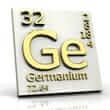Background
- There are two general forms of germanium: organogermanium compounds, which are carbon-containing compounds (carboxyethyl germanium sesquioxide, spirogermanium, propogermanium, Ge-132); and inorganic (non-carbon containing) germanium compounds (Ge, germanium citrate lactate, germanium dioxide). In this monograph, elemental germanium is classified as inorganic. Inorganic germanium is present in all living plant and animal matter in micro-trace quantities.
- In recent years, inorganic germanium salts and novel organogermanium compounds have been sold as nutritional supplements in some countries for their purported immunomodulatory effects or as health-producing elixirs. Bis (2-carboxyethyl germanium sesquioxide), simply called germanium sesquioxide, has been shown in animal studies to have anti-viral and immunological properties including the induction of gamma-interferon, macrophages, T-suppressor cells and augmentation of natural killer cell activity. Another organic germanium, spirogermanium (3-(8,8-diethyl-3-aza-8-germaspiro[4.5]dec-3-yl)-N,N-dimethyl-propan-1-amine), is a heavy metal compound in which germanium has been substituted in an azaspirane ring structure. The supposed therapeutic attributes of organogermaniums include: immunoenhancement, oxygen enrichment, free radical scavenging, analgesia and heavy metal detoxification. However, because of the possibility of contaminated organic germanium products on the market and several unclear and poor-quality scientific reviews, all types of germanium are currently thought of as unsafe.
- The National Nutritional Foods Association continues to support a voluntary ban on the sale of germanium. Based on information accessed on February 2, 2007, the import alert against germanium products (see related terms) remains in effect. This import alert was created in 1988, and amended in 1995 to prevent the importation of germanium-containing products that are deemed as "poisonous and deleterious substances (PSNC)" or "unapproved new drugs (DRND)" by the U.S. Food and Drug Administration (FDA).
References
- Asaka T, Nitta E, Makifuchi T, et al. Germanium intoxication with sensory ataxia. J.Neurol.Sci. 1995;130(2):220-223.
View Abstract - Gerber GB, Leonard A. Mutagenicity, carcinogenicity and teratogenicity of germanium compounds. Mutat.Res. 1997;387(3):141-146.
View Abstract - Hirayama C, Suzuki H, Ito M, et al. Propagermanium: a nonspecific immune modulator for chronic hepatitis B. J Gastroenterol. 2003;38(6):525-532.
View Abstract - Ishiwata Y, Yokochi S, Hashimoto H, et al. Protection against concanavalin A-induced murine liver injury by the organic germanium compound, propagermanium. Scand.J Immunol. 1998;48(6):605-614.
View Abstract - Kaplan BJ, Andrus GM, Parish WW. Germane facts about germanium sesquioxide: II. Scientific error and misrepresentation. J.Altern.Complement Med. 2004;10(2):345-348.
View Abstract - Kaplan BJ, Parish WW, Andrus GM, et al. Germane facts about germanium sesquioxide: I. Chemistry and anticancer properties. J.Altern.Complement Med. 2004;10(2):337-344.
View Abstract - Kuwabara M, Ohba S, Yukawa M. Effect of germanium, poly-trans-[2-carboxyethyl] germasesquioxane on natural killer (NK) activity in dogs. J Vet.Med.Sci. 2002;64(8):719-721.
View Abstract - Long QC, Zeng GX, Zhao XL. Pharmacokinetics of germanium after po beta-carboxyethylgermanium sesquioxide in 24 Chinese volunteers. Zhongguo Yao Li Xue.Bao. 1996;17(5):415-418.
View Abstract - Luck BE, Mann H, Melzer H, et al. Renal and other organ failure caused by germanium intoxication. Nephrol.Dial.Transplant. 1999;14(10):2464-2468.
View Abstract - Mainwaring MG, Poor C, Zander DS, et al. Complete remission of pulmonary spindle cell carcinoma after treatment with oral germanium sesquioxide. Chest 2000;117(2):591-593.
View Abstract - Ming X, Yin H, Zhu Z. [Effect of dietary selenium and germanium on the precancerous lesion in rat glandular stomach induced by N-methyl-N'-nitro-N-nitrosoguanidine]. Zhonghua Wai Ke.Za Zhi. 1996;34(4):221-223.
View Abstract - Shamir M, Sprung CL. [Fatal multiple organ system dysfunction associated with germanium metal used in complementary therapy]. Harefuah 11-16-1997;133(10):446-7, 502.
View Abstract - Tao SH, Bolger PM. Hazard assessment of germanium supplements. Regul.Toxicol.Pharmacol. 1997;25(3):211-219.
View Abstract - Tsutsumi Y, Tanaka J, Kanamori H, et al. Effectiveness of propagermanium treatment in multiple myeloma patients. Eur.J Haematol. 2004;73(6):397-401.
View Abstract - Unakar NJ, Tsui J, Johnson M. Effect of pretreatment of germanium-132 on Na(+)-K(+)-ATPase and galactose cataracts. Curr Eye Res. 1997;16(8):832-837.
View Abstract







